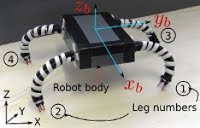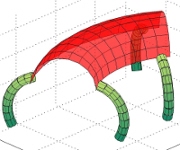Soft-limbed Locomotion
Traditional or classical robots use rigid limbs (inspired by the skeletal structures of animals) to engage in locomotion. However, muscular animals such as squids and octopus demonstrate impressive ability to use their soft muscular arms as articulated rigid limbs to walk on the seabed. Inspired by this behavior I have designed and developed a legged robot. The limbs are made of compliant pneumatic muscle actuators.
Soft bodied robots provide a new paradigm with respect to the more “classical” rigid limbed robots. I have designed, developed and fielded soft continuum limbed robot with a rigid body. Although there is significant novelty in incorporating soft limbs, the rigid body is a drawback in highly penetrative tasks. Hence I am interested in developing a complete soft robot, body and limbs, to step towards to mimic a muscular hydrostats such as octopuses and squids. The research in done in collaboration with Prof. Ian D. Walker at Clemson University. The expected robot will provide a novel, first of its kind, complete soft robot with soft limbs with omni-directional workspace that can generate a range of locomotion gaits. In addition to the primary application as a walking robot, it can also act as an adaptive, gripper or anchorage on demand. This robot will then be an ideal candidate for search and rescue mission in highly congested terrains such as building rubble after a natural disaster.
Research Members: Isuru Godage, Thrishantha Nananyakkara, and Ian D. Walker.


The following videos show the initial design of a such robot, augmenting a soft body to soft limbs. The body is capable of deforming in several shapes, length and width wise.
Publications
- Isuru S Godage, Thrishantha Nanayakkara, Darwin G Caldwell (2012) Locomotion with Continuum Limbs, 293-298. In IEEE/RSJ International Conference on Intelligent Robots and Systems (IROS).
